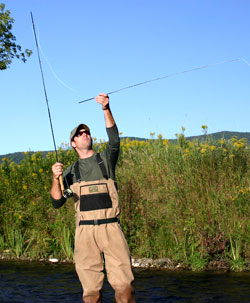How To Avoid Breaking Fly Rods
Have a question you want answered? Email it to us at [email protected].
Question: So I just finished reading the Midcurrent article about rod warranties, and it’s got me wondering: what precautions can I take to avoid breaking my rods?
Joe F., Los Angeles, CA

photo by Phil Monahan
Answer: According to a recent article on the subject by Seattle-based writer Steve Duda, who interviewed some of the best minds in the rod-repair business, the number-one cause of fly rod breakage is “stupidity.” So unless you can figure out a way to make yourself instantly smarter, your best bet is to limit your opportunities to make bonehead mistakes. Some of these rules might seem obvious, but you’d be amazed by how often otherwise savvy anglers break them…and their rods.
1. Don’t put a rod together indoors. I know it’s fun to show your buddy how nicely your brand-new 4-weight wiggles in the living room, but don’t do it. Corollaries to this rule include: don’t walk through a doorway with a fly rod; stay away from ceiling fans; don’t make fake false-casts; and especially don’t do any of the above while under the influence of alcohol.
2. Keep the damned thing in its tube as much as possible. The least likely place for a rod to be broken is in its tube. Don’t take the rod out of the tube until you’re ready to string it and walk down to the river. Too many folks set up the rod and then lean it against the car while they put on their waders. This creates ample opportunities for someone to fall against the rod, for the tip to get crushed in a tailgate, for the wind to blow it onto the ground where someone can step on it, etc. When you’re done for the day, wipe down the rod with a dry cloth and put the rod right back in its tube, even if you’re going to fish with it the next day. Bumping around in the back of a truck or bent to fit in your car, a rod can sustain bumps and bruises that will lead to failure at a later date.
3. Never put the rod flat on the ground. A fly rod lying flat is difficult to see, especially when everyone is wearing sunglasses. One of your fishing buddies is likely to step on it, if you don’t do so first.
4. Be extra careful in boats. Because boats are inherently unstable, people tend to stumble and even fall down in them. If your rod is unprotected, a stray hand, foot, or butt may end your fishing day. When I guided in Alaska, I had a client break three rods (all he’d brought) by accidentally sitting on them the very first time he got in the boat. If your rod is leaning on the gunwales or off the stern, make sure the tip doesn’t get caught in overhanging branches as you float downstream.
5. Check your ferrules regularly. Frequent casting will cause your ferrules to loosen slightly over the course of the day. As the ferrules loosen, there’s less material absorbing the stresses of fish fighting and even just casting. The edges of the female ferrule are usually quite thin, and they often break first.
6. Don’t “high stick” fish. When you’re trying to bring a fish to hand or when it’s right below the boat, an angler’s natural reaction is to rear-back on the fly rod. This puts intense pressure on the tip, which is the most fragile part of the rod. A net with a long handle makes such high-sticking unnecessary. Get one.
7. Keep your hands off the rod blank. In the heat of battle with a heavy fish, many anglers will attempt to “strengthen” the rod by grabbing it above the handle. This has the opposite effect, making the rod weaker because the butt section is taken out of play. Keep your hands on the cork, and let the butt section do the work.
8. Pay attention. Most broken rods occur in circumstances where, had the angler been a little more vigilant, disaster could have been averted. If you keep an eye on your rod tip and are careful about where you put the rod when you’re not fishing, your chances of breaking it decline rapidly.











